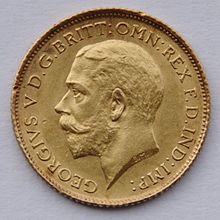Half-sovereign
| United Kingdom | |
| Mass | 3.99 g g |
|---|---|
| Diameter | 19.30 mm |
| Edge | Milled |
| Composition | 22 Carat Gold |
| Years of minting | 1817 |
| Obverse | |
 |
|
| Design | Portrait of reigning monarch |
| Reverse | |
 |
|
| Design | Saint George and the Dragon |
| Designer | Benedetto Pistrucci |
The half sovereign is an English and British gold coin with a face value half that of a sovereign: equivalent to half a pound sterling, ten shillings, or 120 old pence. Since the end of the gold standard, it has been issued only in limited quantities as a commemorative coin with a sale price and resale value far in excess of its face value. The main reason for this is because they are used, along with other coins of this type as bullion coins.
Common date half sovereigns tend to be worth slightly more than melt value (around £130 as of 2017).
The half sovereign was first introduced in 1544 under Henry VIII. After 1604, the issue of half sovereigns, along with gold sovereigns, was discontinued until 1817, following a major revision of British coinage. Production continued until 1926 and, apart from special issues for coronation years, was not restarted until 1980. It was also used extensively in Australia, until 1933.
Modern half sovereigns, from 1817 onwards, have a diameter of 19.30 mm, a thickness of ~0.99 mm, a weight of 3.99 g, are made of 22 carat (91⅔%) crown gold alloy, and contain 0.1176 troy ounces (3.6575 g) of gold. The reverse side, featuring St. George slaying a dragon was designed by Benedetto Pistrucci, whose initials appear to the right of the date.
The half sovereign is a "protected coin" for the purposes of Part II of the Forgery and Counterfeiting Act 1981.
...
Wikipedia
